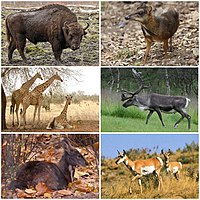
Photo from wikipedia
Abstract This study evaluated the effects of narasin on intake and rumen fermentation characteristics of Bos indicus steers offered a high-forage diet for 140 d. On day 0 of the… Click to show full abstract
Abstract This study evaluated the effects of narasin on intake and rumen fermentation characteristics of Bos indicus steers offered a high-forage diet for 140 d. On day 0 of the study, 30 rumen-fistulated Nellore steers [initial body weight (BW) = 281 ± 21 kg] were assigned to 30 individual pens in a randomized complete block design according to their initial BW. Animals were randomly assigned to 1 of the 3 treatments: 1) forage-based diet without narasin (CONT; n = 10), 2) CONT diet plus 13 ppm of narasin (13NAR; n = 10), and 3) CONT diet plus 20 ppm of narasin (20NAR; n = 10). The forage used was Tifton-85 (Cynodon dactylon spp.), whereas the carrier for narasin was a 50:50 mixture of soybean hull:corn. The experimental period was divided into 5 periods of 28 d each. Throughout the experimental period, total dry matter intake (DMI) was recorded daily, whereas mineral salt intake was recorded weekly. Blood and ruminal fluid samples were collected on day 0 (prior to treatment feeding), 28, 56, 84, 112, and 140 of the study. Moreover, total tract apparent nutrient digestibility was performed for a 5-d period every 28 d. No treatment effects were observed on forage, mineral, concentrate, or total DMI (P ≥ 0.22). Nonetheless, 13NAR tended to have a greater mineral intake vs. 20NAR cohorts (P = 0.08) Narasin-supplemented animals had reduced rumen acetate, Ac:Pr ratio, as well as greater (P ≤ 0.02) rumen propionate concentrations vs. CONT cohorts. Moreover, 13NAR increased rumen propionate and decreased butyrate, Ac:Pr vs. 20NAR cohorts (P ≤ 0.01). Throughout the experimental period, narasin-supplemented animals had reduced ammonia concentrations vs. CONT cohorts (P < 0.01), whereas no differences were observed between 13NAR and 20NAR (P = 0.80). No treatment or dose effects were observed (P ≥ 0.23) on DM, organic matter (OM), protein, neutral detergent fiber (NDF), acid detergent fiber (ADF), and mineral digestibility. Animals fed 13NAR had a reduced mean plasma urea concentration vs. CONT cohorts (P = 0.03), whereas no further differences were observed (P ≥ 0.12). In summary, narasin supplementation to beef steers offered a high-forage diet did not impact forage, mineral, and total DMI, as well as nutrient digestibility, whereas rumen fermentation characteristics, rumen ammonia, and plasma urea concentrations were positively impacted and lasted throughout the experimental period. Additionally, 13 ppm of narasin resulted in a reduced Ac:Pr ratio and rumen ammonia when compared to animals supplemented with 20 ppm.
Journal Title: Translational Animal Science
Year Published: 2020
Link to full text (if available)
Share on Social Media: Sign Up to like & get
recommendations!